Urtica dioica
Urtica dioica, often known as common nettle, burn nettle, stinging nettle (although not all plants of this species sting) or nettle leaf, or just a nettle or stinger, is a herbaceous perennial flowering plant in the family Urticaceae. Originally native to Europe, much of temperate Asia and western North Africa,[2] it is now found worldwide. The species is divided into six subspecies, five of which have many hollow stinging hairs called trichomes on the leaves and stems, which act like hypodermic needles, injecting histamine and other chemicals that produce a stinging sensation upon contact ("contact urticaria", a form of contact dermatitis).[3][4]
| Urtica dioica | |
|---|---|
.jpg.webp) | |
| Urtica dioica subsp. dioica | |
| Scientific classification | |
| Kingdom: | Plantae |
| Clade: | Tracheophytes |
| Clade: | Angiosperms |
| Clade: | Eudicots |
| Clade: | Rosids |
| Order: | Rosales |
| Family: | Urticaceae |
| Genus: | Urtica |
| Species: | U. dioica |
| Binomial name | |
| Urtica dioica | |
The plant has a long history of use as a source for traditional medicine, food, tea, and textile raw material in ancient (such as Saxon) and modern societies.[2][5]
Description
Urtica dioica is a dioecious, herbaceous, perennial plant, 3 to 7 feet (0.9 to 2 metres) tall in the summer and dying down to the ground in winter.[6] It has widely spreading rhizomes and stolons, which are bright yellow, as are the roots. The soft, green leaves are 1 to 6 inches (30 to 200 mm) long and are borne oppositely on an erect, wiry, green stem. The leaves have a strongly serrated margin, a cordate base, and an acuminate tip with a terminal leaf tooth longer than adjacent laterals. It bears small, greenish or brownish, numerous flowers in dense axillary inflorescences.
The leaves and stems are very hairy with non-stinging hairs, and in most subspecies, also bear many stinging hairs (trichomes or spicules), whose tips come off when touched, transforming the hair into a needle that can inject several chemicals causing a painful sting or paresthesia, giving the species its common names: stinging nettle, burn-nettle, burn-weed, or burn-hazel.[6][3][7]
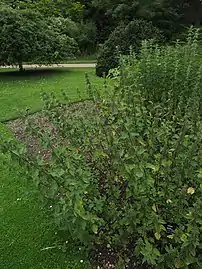 Specimen in the Cambridge University Botanic Garden
Specimen in the Cambridge University Botanic Garden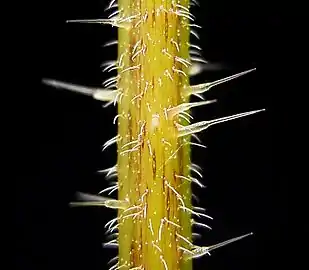 Close-up of the defensive hairs
Close-up of the defensive hairs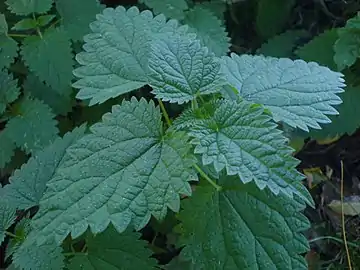 Young shoot leaves
Young shoot leaves Leaf detail
Leaf detail Flowers (male) can be yellow
Flowers (male) can be yellow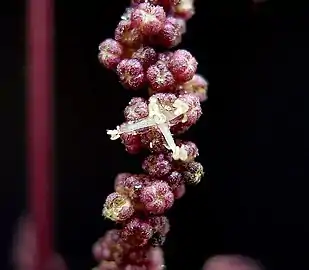 Flowers (male) can be purple
Flowers (male) can be purple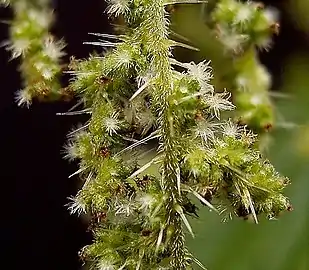 Flowers (female) can be green and white
Flowers (female) can be green and white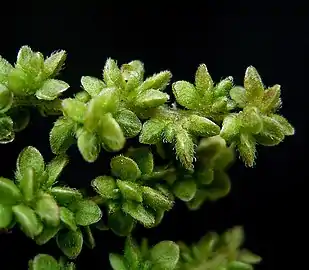 Fruits
Fruits_pollen.tif.jpg.webp) Pollen
Pollen Processed Urtica dioica pollen, 40x
Processed Urtica dioica pollen, 40x
Taxonomy
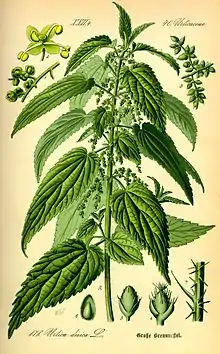
Credit for the scientific naming of Urtica dioica is given to Carl Linnaeus who published it in Species Plantarum in 1753.[2] The taxonomy of Urtica species is confused, and sources are likely to use a variety of systematic names for these plants. Until 2014 there was broad consensus that the nettles native to the Americas, now classified as Urtica gracilis, were subspecies of Urtica dioica. However, in that year the paper "Weeding the Nettles II" was published in the journal Phytotaxa demonstrating the genetic distinctness of new world nettles.[8] As of 2023 Plants of the World Online (POWO) recognizes U. gracilis as a distinct species while the USDA Natural Resources Conservation Service PLANTS database (PLANTS) continues to list it as U. dioica subsp. gracilis as does the Flora of North America (FNA).[9][10][11]
As of 2023 POWO and recognizes 11 subspecies or varieties of U. dioica.[2]
- Urtica dioica subsp. afghanica Chrtek, from southwestern and central Asia, sometimes has stinging hairs or is sometimes hairless.[12]
- Urtica dioica subsp. dioica (European stinging nettle), from Europe, Asia, and northern Africa, has stinging hairs.[13]
- Urtica dioica subsp. gansuensis C.J.Chen, from eastern Asia (China), has stinging hairs.[12]
- Urtica dioica var. glabrata (Clem.) Asch. & Graebn.
- Urtica dioica var. hispida (Lam. ex DC.) Tausch ex Ott
- Urtica dioica var. holosericea Fr.
- Urtica dioica subsp. kurdistanica Chrtek
- Urtica dioica subsp. pubescens(Ledeb.) Domin, in many sources as U. dioica subsp. galeopsifolia (fen nettle or stingless nettle), from Europe, does not have stinging hairs.[14]
- Urtica dioica var. sarmatica Zapał.
- Urtica dioica subsp. sondenii(Simmons) Hyl.
- Urtica dioica subsp. subinermis (R.Uechtr.) Weigend
Distribution and habitat
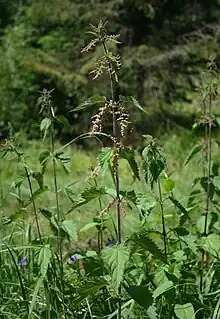
U. dioica is considered to be native to Europe, much of temperate Asia and western North Africa.[2] It is abundant in northern Europe and much of Asia, usually found in the countryside. It is less widespread in southern Europe and north Africa, where it is restricted by its need for moist soil, but is still common. It has been introduced to many other parts of the world. In North America, it is widely distributed in Canada and the United States, where it is found in every province and state except for Hawaii, and also can be found in northernmost Mexico. It grows in abundance in the Pacific Northwest, especially in places where annual rainfall is high. The European subspecies has been introduced into Australia, North America and South America.[16][17]
In Europe, nettles have a strong association with human habitation and buildings. The presence of nettles may indicate the site of a long-abandoned building, and can also indicate soil fertility.[18] Human and animal waste may be responsible for elevated levels of phosphate[19] and nitrogen in the soil, providing an ideal environment for nettles.
Ecology

Nettles are the larval food plant for several species of butterflies, such as the peacock butterfly,[20] comma (Polygonia c-album), and the small tortoiseshell. It is also eaten by the larvae of some moths including angle shades, buff ermine, dot moth, the flame, the gothic, grey chi, grey pug, lesser broad-bordered yellow underwing, mouse moth, setaceous Hebrew character, and small angle shades. The roots are sometimes eaten by the larva of the ghost moth (Hepialus humuli).
It is a known host to the pathogenic fungus Phoma herbarum.[21]
Stinging nettle is particularly found as an understory plant in wetter environments, but it is also found in meadows. Although nutritious, it is not widely eaten by either wildlife or livestock, presumably because of the sting. It spreads by abundant seeds and also by rhizomes, and is often able to survive and re-establish quickly after fire.[22]
Cultivation
Sowing and planting
Three cultivation techniques can be used for the stinging nettle: 1) direct sowing, 2) growing seedlings in nurseries with subsequent transplantation and 3) vegetative propagation via stolons or head cuttings.[23]
- Direct sowing: The seedbed should have a loose and fine structure, but should be reconsolidated using a packer roller imminently prior to sowing.[24] Sowing time can be either in autumn[25] or in spring.[26] Seed density should be 6 kilograms/hectare with row spacing of 30 cm (12 in) and 42–50 cm in autumn and spring, respectively.[24][25][27] The disadvantage of direct sowing is that it usually leads to incomplete plant coverage.[24][27] This drawback can be mitigated by covering the seedbed with a transparent perforated foil in order to improve seed germination.[24][25] Further, weed control can be problematic as the stinging nettle has a slow seedling development time.[24]
- Growing seedlings: For this technique pre-germinated seeds are sown between mid-/end-February and beginning of April and grown in nurseries. Seedlings are grown in tuffs with 3–5 plants/tuff and a seed density of 1.2–1.6 kg/1000 tuffs. A fastened germination is achieved by alternating high temperature during daytime (30 °C for 8 h) and lower temperature during nighttime (20 °C for 16 h).[24][27] Before transplanting, the seedlings should be fertilized and acclimated to cold temperatures.[24] Transplantation should start around Mid-April with row spacing of 42–50 cm (17–20 in) and plant spacing within rows of 25–30 cm.[26][27]
- Vegetative propagation: Stolons (with several buds) of 10 cm should be planted from mid-April in a depth of 5–7 cm (2–2+3⁄4 in).[26] Head cuttings are grown in nurseries starting between mid-May and mid-June. Growing tips with two leaf pairs are cut from the mother plant and treated with root-growth inducing hormones. Transplantation can be delayed in comparison to the growing seedling technique.[24]
Greenhouse
The stinging nettle can also be grown in controlled-environment agriculture systems, such as soil-less medium cultivations or aeroponics, which may achieve higher yields, standardize quality, and reduce harvesting costs and contamination.[28]
Sting and treatment
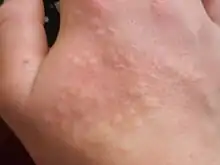
Urtica dioica produces its inflammatory effect on skin (stinging, burning sensation often called "contact urticaria") both by impaling the skin via spicules – causing mechanical irritation – and by biochemical irritants, such as histamine, serotonin, and acetylcholine, among other chemicals.[3][29][30][31][32] Anti-itch drugs, usually in the form of creams containing antihistamines or hydrocortisone, may provide relief from nettle dermatitis.[3] The term, contact urticaria, has a wider use in dermatology, involving dermatitis caused by various skin irritants and pathogens.[33]
Docks, especially the broad-leaf dock (Rumex obtusifolius) often grow in similar environments to stinging nettles and are regarded as a folk remedy to counteract the sting of a nettle,[34] although there is no evidence of any chemical effect. It may be that the act of rubbing a dock leaf against a nettle sting acts as a distracting counterstimulation, or that belief in the dock's effect provides a placebo effect.[35]
Uses
Culinary
U. dioica has a flavour similar to spinach when cooked. Young plants were harvested by Native Americans and used as a cooked plant in spring when other food plants were scarce.[36] Soaking stinging nettles in water or cooking removes the stinging chemicals from the plant, which allows them to be handled and eaten without injury.[37] After the stinging nettle enters its flowering and seed-setting stages, the leaves develop gritty particles called cystoliths. Many sources claim consumption of these can irritate the kidneys and urinary tract;[36][38]: 106–107 however, there is no medical evidence to support this claim. Cystoliths are made of calcium carbonate, and will not dissolve when boiled. Leaves harvested post-flowering must have their cystoliths broken down by acid, as in the fermentation process. In its peak season, nettle contains up to 25% protein, dry weight, which is high for a leafy green vegetable.[39] The leaves are also dried and may then be used to make a herbal tea, as can also be done with the nettle's flowers.
Nettles can be used in a variety of recipes, such as polenta, pesto, and purée.[40] Nettle soup is a common use of the plant, particularly in Northern and Eastern Europe.
Nettles are sometimes used in cheesemaking, such as for Cornish Yarg[41] and as a flavouring in varieties of Gouda.[42]
Nettles are used in Montenegro, Serbia, and Bosnia and Herzegovina as part of the dough filling for the börek pastry. The top baby leaves are selected and simmered, and then mixed with other ingredients such as herbs and rice, before being used as a filling between dough layers.[43][44] Similarly, in Greece the tender leaves are often used, after simmering, as a filling for hortopita, which is similar to spanakopita, but with wild greens rather than spinach for filling.[45]
Young nettles can also be used to make an alcoholic drink.[46]
Competitive eating
In the UK, an annual World Nettle Eating Championship draws thousands of people to Dorset, where competitors attempt to eat as much of the raw plant as possible. Competitors are given 60 cm (24 in) stalks of the plant, from which they strip the leaves and eat them. Whoever strips and eats the most stinging nettle leaves in a fixed time is the winner. The competition dates back to 1986, when two neighbouring farmers attempted to settle a dispute about which had the worst infestation of nettles, and one of them said, "I'll eat any nettle of yours that's longer than mine."[47][48]
Traditional medicine
As Old English stiðe, nettle is one of the nine plants invoked in the pagan Anglo-Saxon Nine Herbs Charm, recorded in 10th-century traditional medicine. Nettle was believed to be a galactagogue – a substance that promotes lactation.[49] Urtication, or flogging with nettles, is the process of deliberately applying stinging nettles to the skin to provoke inflammation. An agent thus used was considered to be a rubefacient (something that causes redness), used as a folk remedy for treating rheumatism.[50] A study undertaken in 2000 showed that nettles were an effective therapy in relieving the pain of arthritis.[51][52]
Chastisement
In indigenous justice systems in Ecuador, urtication was used as punishment for severe crimes in 2010. The sentenced perpetrator of a crime was flogged with stinging nettle, in public, naked, whilst being showered with freezing cold water.[53]
Textiles and fibre
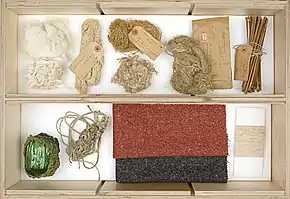
Nettle stems contain a bast fibre that has been traditionally used for the same purposes as linen and is produced by a similar retting process. Unlike cotton, nettles grow easily without pesticides. The fibres are coarser, however.[54]
Historically, nettles have been used to make clothing for almost 3,000 years, as ancient nettle textiles from the Bronze Age have been found in Denmark.[55] It is widely believed that German Army uniforms were almost all made from nettle during World War I due to a potential shortage of cotton, although there is little evidence to support this.[56] More recently, companies in Austria, Germany, and Italy have started to produce commercial nettle textiles.[57][58]
The fibre content in nettle shows a high variability and reaches from below 1% to 17%. Under middle-European conditions, stems yield typically between 45 and 55 dt / ha (decitons per hectare), which is comparable to flax stem yield. Due to the variable fibre content, the fibre yields vary between 0.2 and 7 dt / ha, but the yields are normally in the range between 2 and 4 dt / ha.[59] Fibre varieties are normally cloning varieties and therefore planted from vegetative propagated plantlets. Direct seeding is possible, but leads to great heterogeneity in maturity.[60]
Nettles may be used as a dye-stuff, producing yellow from the roots, or yellowish green from the leaves.[61]
Nutrient contents
Fresh leaves contain approximately 82.4% water, 17.6% dry matter, 5.5% protein, 0.7 to 3.3% fat, and 7.1% carbohydrates.[62] Mature leaves contain about 40% α- linolenic acid, a valuable omega-3 acid.[63] For exact fatty acid contents see Table 1. Seeds contain much more fatty acid than leaves.[63]
| Mature leaves | Young leaves | Seeds | Stems | Roots | ||
|---|---|---|---|---|---|---|
| Moisture (% fresh weight) | 72.8 (± 5.1) | 82.0 (± 3.7) | 47.6 (± 2.1) | 50.1 (± 2.4) | 40.3 (± 2.8) | |
| Saponifiable oil (% fresh weight) | 2.1 (± 0.3) | 3.3 (± 0.2) | 15.1 (± 2.0) | 1.5 (± 0.1) | 0.1 (± 0.0) | |
| Fatty acids (% of saponifiable oil) | ||||||
| Palmitic | 16:0 | 17.9 (± 1.1) | 20.1 (± 0.9) | 25.4 (± 1.9) | 23.6 (± 2.1) | 24.0 (± 0.8) |
| Palmitoleic | 16:1n-7 | 3.0 (± 0.2) | 3.9 (± 0.3) | 0.7 (± 0.0) | 0.5 (± 0.0) | 2.6 (± 0.3) |
| Stearic | 18:0 | 1.6 (± 0.3) | 1.9 (± 0.1) | 2.3 (± 0.3) | 1.8 (± 0.2) | 1.6 (± 0.1) |
| Oleic | 18:1n-9 | 1.7 (± 0.2) | 2.8 (± 0.2) | 4.8 (± 0.3) | 2.1 (± 0.2) | 8.7 (± 0.5) |
| Linoleic | 18:2n-6 | 11.6 (± 1.0) | 18.1 (± 1.3) | 22.7 (± 1.9) | 33.8 (± 2.9) | 34.3 (± 2.7) |
| α- Linolenic | 18:3n-3 | 40.7 (± 3.2) | 29.6 (± 2.1) | 6.6 (± 4.9) | 12.2 (± 1.0) | 2.3 (± 0.1) |
| Gadoleic | 20:1n-9 | 0.8 (± 0.0) | 0.7 (± 0.0) | 2.1 (± 0.2) | 1.5 (± 0.1) | 1.2 (± 0.0) |
| Erucic | 22:1n-9 | 0.4 (± 0.0) | 0.5 (± 0.1) | 1.2 (± 0.2) | 0.9 (± 0.2) | 0.9 (± 0.1) |
| Omega-3 : Omega-6 Ratio | n-3/n-6 | 3.51 | 1.64 | 0.29 | 0.65 | 0.07 |
Minerals (Ca, K, Mg, P, Si, S, Cl) and trace elements (Ti, 80 ppm,[64] Mn, Cu, Fe) contents depend mostly on the soil and the season.[62]
Carotenoids can be found primarily in the leaves, where different forms of lutein, xanthophyll and carotene are present (Table 2). Some carotenes are precursors of vitamin A (retinol), their retinol equivalents RE or retinol activity equivalents per g dry weight are 1.33 for mature leaves and 0.9 for young leaves.[62] Nettle contains much less carotenes and retinol than carrots, which contain 8.35 RE per g fresh weight.[65] Depending on the batch and the leave and stem content, nettle contains only traces of zeaxanthin or between 20–60 mg/kg of dry matter.[62][66] Nettle contains ascorbic acid (vitamin C), riboflavin (vitamin B2), pantothenic acid, vitamin K1[62] and tocopherols (vitamin E).[66] The highest vitamin contents can be found in the leaves.[62]
| Mature leaves | Young leaves | ||
|---|---|---|---|
| Total identified carotenoids | 74.8 | 51.4 | |
| Xanthophylls | Neoxanthin | 5.0 (± 0.2) | 2.6 (± 0.2) 0 |
| Violaxanthin | 11.0 (± 0.2) | 7.2 (± 0.6) | |
| Zeaxanthin | traces | traces | |
| β-cryptoxanthin | traces | traces | |
| Luteins | 13-cis-lutein | 0.4 (± 0.0) | 0.4 (± 0.0) |
| 13'-cis-lutein | 8.4 (± 0.4) | 5.0 (± 0.6) | |
| All-trans-lutein | 32.4 (± 1.0) | 23.6 (± 0.8) | |
| 9-cis-lutein | 1.2 (± 0.2) | 1.0 (± 0.2) | |
| 9'-cis-lutein | 4.4 (± 0.4) | 3.4 (± 0.6) | |
| Carotenes | All-trans-β-carotene | 5.6 (± 0.7) | 3.8 (± 0.3) |
| β-carotene-cis-isomers | 4.8 (± 0.2) | 3.2 (± 0.2) | |
| Lycopene | 1.6 (± 0.1) | 1.2 (± 0.1) | |
| Retinol equivalent | RE / g dry wt | 1.33 (± 0.3) | 0.90 (± 0.3) |
Poultry: Egg yolk colouring in laying hens
In laying hens, nettle can be used as an egg yolk colorant instead of artificial pigments or other natural pigments (derived from marigold for yellow). Nettle has high carotenoid contents, especially lutein, β-carotene and zeaxanthin, of which lutein and zeaxanthin act as yellow pigments.[66][67][68] Feeding as little as 6.25 g dry nettle per kg feed is as effective as the synthetic pigments to colour the egg yolk. Feeding nettle has no detrimental effect on the performance of the laying hens or on the general quality of eggs.[66]
Ruminants
Ruminants avoid fresh stinging nettles; however, if the nettles are wilted or dry, voluntary intake can be high.
| Ryegrass silage | Nettle silage | ||
|---|---|---|---|
| Dry matter | DM | 235 | 415 |
| Metabolizable energy (MJ/ kg DM) | ME | 11.3 | 9.8 |
| Crude protein | CP | 177 | 171 |
| Neutral detergent fibre | NDF | 536 | 552 |
| Acid detergent fibre | ADF | 338 | 434 |
| Starch | - | - | |
| Ash | 113 | 118 |
Use in agriculture / horticulture
In the European Union and United Kingdom, nettle extract can be used as an insecticide, fungicide, and acaricide under Basic Substance regulations.[70] As an insecticide nettle extract can be used for the control of codling moth, diamondback moth, and spider mites. As a fungicide, it can be used for the control of Pythium root rot, powdery mildew, early blight, late blight, Septoria blight, Alternaria leaf spot, and grey mould.[71]
Gardening
Nettles have a number of other uses in the vegetable garden, including the potential for encouraging beneficial insects. Since nettles prefer to grow in phosphorus-rich and nitrogen rich soils that have recently been disturbed (and thus aerated), the growth of nettles is an indicator that an area has high fertility (especially phosphate and nitrate),[72][73] and thus is an indicator to gardeners as to the quality of the soil.[74][75]
Nettles contain nitrogenous compounds, so are used as a compost activator[76] or can be used to make a liquid fertilizer, which although low in phosphate, is useful in supplying magnesium, sulphur, and iron.[77][78] They are also one of the few plants that can tolerate, and flourish in, soils rich in poultry droppings.
The stinging nettle is the red admiral caterpillar's primary host plant and can attract migrating red admiral butterflies to a garden.[79] U. dioica can be a troubling weed, and mowing can increase plant density.[80] Regular and persistent tilling will greatly reduce its numbers, and the use of herbicides such as 2,4-D and glyphosate are effective control measures.[80]
Culture
In Great Britain and Ireland, U. dioica and the annual nettle Urtica urens are the only common stinging plants and have found a place in several figures of speech in the English language. Shakespeare's Hotspur urges that "out of this nettle, danger, we pluck this flower, safety" (Henry IV, Part 1, Act II Scene 3). The figure of speech "to grasp the nettle" probably originated from Aesop's fable "The Boy and the Nettle".[81] In Seán O'Casey's Juno and the Paycock, one of the characters quotes Aesop "Gently touch a nettle and it'll sting you for your pains/Grasp it as a lad of mettle and soft as silk remains". The metaphor may refer to the fact that if a nettle plant is grasped firmly rather than brushed against, it does not sting so readily, because the hairs are crushed down flat and do not penetrate the skin so easily.[82]
In the German language, the idiom sich in die Nesseln setzen, or to sit in nettles, means to get into trouble. In Hungarian, the idiom csalánba nem üt a mennykő, the lightning bolt does not strike into nettles, alludes to the belief that bad people escape trouble or the devil looks after his own.[83] The same idiom exists in the Serbian language – неће гром у коприве. In Dutch, a netelige situatie means a predicament. In French, the idiom faut pas pousser mémé dans les orties (do not push granny into the nettles) means that we should be careful not to abuse a situation. The name urticaria for hives comes from the Latin name of nettle (Urtica, from urere, to burn).
The English word 'nettled', meaning irritated or angry, is derived from 'nettle'.[84]
There is a common idea in Great Britain that the nettle was introduced by the Romans.[85] The idea was mentioned by William Camden in his book Britannia of 1586.[86] However, in 2011, an early Bronze Age burial cist on Whitehorse Hill,[87][88] Dartmoor, Devon was excavated. The cist dated from between 1730 and 1600 BC. It contained various high value beads as well as fragments of a sash made from nettle fibre. It is possible that the sash was traded from mainland Europe, but perhaps more probable that it was locally made.
See also
References
- Maiz-Tome, L. 2016. Urtica dioica. The IUCN Red List of Threatened Species 2016: e.T167815A78457212. https://dx.doi.org/10.2305/IUCN.UK.2016-1.RLTS.T167815A78457212.en. Accessed on 08 December 2022.
- "Urtica dioica L." Plants of the World Online. Royal Botanic Gardens, Kew. Retrieved 31 May 2023.
- "Nettles". Drugs.com. 2009. Retrieved 23 April 2018.
- Per Brodal (2010). The Central Nervous System: Structure and Function. Oxford University Press US. p. 170. ISBN 978-0-19-538115-3. Retrieved 22 September 2010.
- Lukešová, Hana (June 2017). "Identifying plant fibre textiles from Norwegian Merovingian Period and Viking Age graves: The Late Iron Age Collection of the University Museum of Bergen". Journal of Archaeological Science: Reports. 13: 281–285. Bibcode:2017JArSR..13..281L. doi:10.1016/j.jasrep.2017.03.051.
- "Urtica dioica - L". Plants for a Future. 2012. Retrieved 23 April 2018.
- "Burning & Stinging Nettles". University of California. Retrieved 21 September 2013.
- Henning, T.; Quandt, D.; Große-Veldmann, B.; Monro, A.K.; Weigend, M. (2014). "Weeding the Nettles II: A delimitation of 'Urtica dioica L.' (Urticaceae) based on morphological and molecular data, including a rehabilitation of Urtica gracilis Ait.". Phytotaxa. 162 (2): 61–83. doi:10.11646/phytotaxa.162.2.1.
- "Urtica gracilis Aiton". Plants of the World Online. Royal Botanic Gardens, Kew. Retrieved 31 May 2023.
- Urtica dioica L. ssp. gracilis (Aiton) Seland., USDA Natural Resources Conservation Service PLANTS Profile, 9 June 2023
- Boufford, David E. (5 November 2020). "Urtica dioica subsp. gracilis - FNA". Flora of North America. Retrieved 9 June 2023.
- Chen Jiarui; Ib Friis; C. Melanie Wilmot-Dear. "Flora of China online". efloras, Missouri Botanical Garden, St. Louis, MO & Harvard University Herbaria, Cambridge, MA.
- "Urtica dioica subsp. dioica". Plants of the World Online. Royal Botanic Gardens, Kew. Retrieved 31 May 2023.
- "Urtica dioica subsp. pubescens (Ledeb.) Domin". Plants of the World Online. Royal Botanic Gardens, Kew. Retrieved 31 May 2023.
- Gledhill, David (2008). "The Names of Plants". Cambridge University Press. ISBN 9780521866453 (hardback), ISBN 9780521685535 (paperback). pp 142, 395
- "Species: Urtica dioica". United States Forest Service. Retrieved 21 September 2013.
- "Stinging Nettle". Ohio Agricultural Research and Development Center, Ohio State University. Retrieved 21 September 2013.
- "Nettles: Bad guys come good". The Telegraph Online. 29 April 2010. Archived from the original on 12 January 2022. Retrieved 21 February 2019.
- Smith, Paul L. (2012). Indicator Plants: Using Plants to Evaluate the Environment. p. 47.
- Heiko Bellmann: Der Neue Kosmos Schmetterlingsführer, Schmetterlinge, Raupen und Futterpflanzen, pg. 170, Frankh-Kosmos Verlags-GmbH & Co, Stuttgart 2003, ISBN 3-440-09330-1.
- Helgi Hallgrímsson & Guðríður Gyða Eyjólfsdóttir (2004). Íslenskt sveppatal I - smásveppir [Checklist of Icelandic Fungi I - Microfungi. Fjölrit Náttúrufræðistofnunar. Náttúrufræðistofnun Íslands [Icelandic Institute of Natural History]. ISSN 1027-832X
- Carey, Jennifer H. (1995). "Urtica dioica". Fire Effects Information System, [Online].
- Heyland, Klaus-Ulrich (2006). "Ölfrüchte, Faserpflanzen, Arzneipflanzen und Sonderkulturen". Handbuch des Pflanzenbaues. 4.
- Bomme, U. (1996). "Kulturanleitung für Brennnesseln". Bayerische Landesanstalt für Bodenkultur und Pflanzenbau, Abteilung Pflanzenbau und Pflanzenzüchtung, LBP Freising.
- Heeger, E. F. (1956). Handbuch des Arznei- und Gewürzpflanzenbaus. Leipzig: Deutscher Bauernverlag.
- Bomme U.; Unterholzerner S (1996). "Günstigste Verfahren zum Anbau der Grossen Brennnessel". Gemüse. 3: 233–234.
- Dachler M.; Pelzmann H. (1999). "Arznei- und Gewürzpflanzen". Anbau — Ernte — Aufbereitung. 2. Auflage.
- Pagliarulo, C.L; Hayden, A.L; Giacomelli, G.A (2004). "Potential for Greenhouse Aeroponic Cultivation of Urtica Dioica". Acta Horticulturae (659): 61–66. doi:10.17660/ActaHortic.2004.659.6. S2CID 14875913.
- Cummings, Alexander J; Olsen, Michael (2011). "Mechanism of Action of Stinging Nettles". Wilderness & Environmental Medicine. 22 (2): 136–139. doi:10.1016/j.wem.2011.01.001. PMID 21396858.
- Nettle (Stinging). Wildflowerfinder.org.uk. Retrieved on 3 July 2012.
- Louis J. Casarett; Curtis D. Klaassen; John Doull (2008). Casarett and Doull's toxicology: the basic science of poisons. McGraw-Hill Professional. pp. 1104–. ISBN 978-0-07-147051-3. Retrieved 22 September 2010.
- Michael I. Greenberg (4 June 2003). Occupational, industrial, and environmental toxicology. Elsevier Health Sciences. pp. 180–. ISBN 978-0-323-01340-6. Retrieved 22 September 2010.
- Adisesh, A; Robinson, E; Nicholson, P.J; Sen, D; Wilkinson, M; Standards of Care Working Group (2013). "U.K. Standards of care for occupational contact dermatitis and occupational contact urticaria". British Journal of Dermatology. 168 (6): 1167–1175. doi:10.1111/bjd.12256. PMC 3734701. PMID 23374107.
- "Recorded uses of' dock (Rumex sp.)". Ethnomedica. Archived from the original on 20 November 2008. Retrieved 15 April 2008.
- Hopcroft, Keith (10 September 2005). "Home remedies: dock leaves for nettle stings". Retrieved 29 August 2020.
- Gregory L. Tilford, Edible and Medicinal Plants of the West, ISBN 0-87842-359-1
- Nyerges, Christopher (2016). Foraging Wild Edible Plants of North America: More than 150 Delicious Recipes Using Nature's Edibles. Rowman & Littlefield. p. 130. ISBN 978-1-4930-1499-6.
- Renton, Marlow; Biggane, Eric (2019). Foraging Pocket Guide (2020 ed.). Wild Foods UK. ISBN 978-1-9999222-2-1.
- Hughes, R. Elwyn; Ellery, Peter; Harry, Tim; Jenkins, Vivian; Jones, Eleri (1980). "The dietary potential of the common nettle". Journal of the Science of Food and Agriculture. 31 (12): 1279–86. Bibcode:1980JSFA...31.1279H. doi:10.1002/jsfa.2740311210. PMID 6259444.
- 1069 Recetas de Cocina Archived 5 February 2013 at archive.today (No 423). Wattpad.com (12 May 2010). Retrieved on 3 July 2012.
- "Lynher Dairies Nettles & Garlic". Lynherdairies.co.uk. Archived from the original on 19 October 2012. Retrieved 5 July 2010.
- "Gouda Cheese with Stinging Nettles: Cooking Terms". RecipeTips.com. Retrieved 5 July 2010.
- "Byrek me hithra" (in Albanian). Hermes News. 19 March 2012. Archived from the original on 24 October 2014. Retrieved 14 May 2017.
- "Byrek me hithra" [Recipe: Nettles Pie] (in Albanian). 13 February 2013. Archived from the original on 2 July 2017. Retrieved 14 May 2017.
- "What's In Your Horta?". Greek Cooking. GreekBoston. 21 June 2015. Retrieved 14 May 2017.
- Wright, John (18 May 2011). "Homebrew from the hedgerow: nettle beer". The Guardian. ISSN 0261-3077. Retrieved 10 April 2020.
- "World nettle eating championships". BBC News. 17 June 2005. Retrieved 3 July 2012.
- Langley, William (14 June 2009). "World Stinging Nettle Eating Championship attracts record crowd". The Daily Telegraph. London. Archived from the original on 12 January 2022. Retrieved 3 July 2012.
- Westfall, Rachel Emma (2003). "Galactagogue herbs: a qualitative study and review". Canadian Journal of Midwifery Research and Practice. 2 (2): 22–27.
- "Stinging nettles". BBC. Archived from the original on 17 January 2014. Retrieved 21 September 2013.
- "Nettles 'ease arthritis suffering'". BBC News. 31 May 2000. Retrieved 10 April 2023.
- Randall C, Randall H, Dobbs F, Hutton C, Sanders H (2000). "Randomized controlled trial of nettle sting for treatment of base-of-thumb pain". Journal of the Royal Society of Medicine. 93 (6): 305–309. doi:10.1177/014107680009300607. PMC 1298033. PMID 10911825.
- Caselli, Irene (27 July 2010). "Ecuador's indigenous justice system on trial". BBC. Retrieved 17 April 2020.
- "Student shows off nettle knickers". BBC News. 1 July 2004. Retrieved 24 May 2010.
- Bergfjord, C. (2012). "Nettle as a distinct Bronze-Age textile plant". Scientific Reports. 2: 664. Bibcode:2012NatSR...2E.664B. doi:10.1038/srep00664. PMC 3460533. PMID 23024858.
- Edom, G.(2019), From Sting to Spin: A History of Nettle Fibre, Urtica Books
- Neustatter, Angela (27 February 2008). "Rash thinking". The Guardian.
- Flintoff, John-Paul (20 August 2009). "Second skin: why wearing nettles is the next big thing". The Ecologist.
- Wurl, Günter; Graf, Torsten; Vettel, Armin; Biertümpfel, Andrea. "10 Jahre anbautechnische Versuche zu Fasernesseln (Urtica dioica L.) in Thüringen" (PDF). Thüringer Landesanstalt für Landwirtschaft.
- Vogl, C.R; Hartl, A (2009). "Production and processing of organically grown fiber nettle (Urtica dioica L.) and its potential use in the natural textile industry: A review". American Journal of Alternative Agriculture. 18 (3): 119. doi:10.1079/AJAA200242. S2CID 54916789.
- Piers Warren, 101 uses for Stinging Nettles (2006), p. 65, ISBN 0-9541899-9-X.
- Lutomski, Jerzy; Speichert, Henryk (1983). "Die Brennessel in Heilkunde und Ernährung". Pharmazie in unserer Zeit (in German). 12 (6): 181–186. doi:10.1002/pauz.19830120602. PMID 6657715.
- Guil-Guerrero, J.L; Rebolloso-Fuentes, M.M; Isasa, M.E.Torija (2003). "Fatty acids and carotenoids from Stinging Nettle (Urtica dioica L.)". Journal of Food Composition and Analysis. 16 (2): 111–119. doi:10.1016/S0889-1575(02)00172-2.
- Emsley, John (2001). "Titanium". Nature's Building Blocks: An A-Z Guide to the Elements. Oxford, England, UK: Oxford University Press. p. 451. ISBN 978-0-19-850340-8.
- "USDA National Nutrient Database: raw carrot". Archived from the original on 12 March 2016. Retrieved 28 November 2015.
- Loetscher, Y; Kreuzer, M; Messikommer, R.E (2013). "Utility of nettle (Urtica dioica) in layer diets as a natural yellow colorant for egg yolk". Animal Feed Science and Technology. 186 (3–4): 158–168. doi:10.1016/j.anifeedsci.2013.10.006.
- Loetscher, Y; Kreuzer, M; Messikommer, R. E (2013). "Oxidative stability of the meat of broilers supplemented with rosemary leaves, rosehip fruits, chokeberry pomace, and entire nettle, and effects on performance and meat quality". Poultry Science. 92 (11): 2938–2948. doi:10.3382/ps.2013-03258. PMID 24135598.
- Keshavarz, Mehdi; Rezaeipour, Vahid; Asadzadeh, Sakineh (2014). "Growth Performance, Blood Metabolites, Antioxidant Stability and Carcass Characteristics of Broiler Chickens Fed Diets Containing Nettle (Urtica dioica. L) Powder or Essential Oil". International Journal of Advanced Biological and Biomedical Research. 2 (9): 2553–2561. ISSN 2322-4827.
- Humphries, D.J; Reynolds, C.K (2014). "The effect of adding stinging nettle (Urtica dioica) haylage to a total mixed ration on performance and rumen function of lactating dairy cows". Animal Feed Science and Technology. 189: 72–81. doi:10.1016/j.anifeedsci.2014.01.006.
- European Union. "Final Review report for the basic substance Urtica spp. Finalised in the Standing Committee on Plants, Animals, Food and Feed at its meeting on 24 January 2017" (PDF).
- Sharp, Dr Russell (22 November 2021). "Basic Substances; what are they and how can they used for pest and disease control on farms?". Eutrema. Archived from the original on 23 November 2021. Retrieved 24 November 2021.
- "Nettles as weeds / RHS Gardening". www.rhs.org.uk. Retrieved 25 March 2022.
- "Common nettle | Garden Organic". www.gardenorganic.org.uk. Retrieved 25 March 2022.
- "Indicator Weeds and Soil Conditions at". Garden-helper.com. Retrieved 5 July 2010.
- "virtual-herb-walk". Herbalpractitioner.com. Retrieved 5 July 2010.
- "h2g2 – Stinging Nettles". BBC DNA. Retrieved 5 July 2010.
- Pears, Pauline, et al. HDRA Encyclopedia Of Organic Gardening, p. 207, Dorling Kindersley Ltd, London, 2005.
- "Compost Teas vs Other Teas and Extracts". Ciwmb.ca.gov. Retrieved 5 July 2010.
- Bryant, Simon; Thomas, Chris; Bale, Jeffrey (1997). "Nettle-feeding nymphalid butterflies: Temperature, development and distribution". Ecological Entomology. 22 (4): 390–398. doi:10.1046/j.1365-2311.1997.00082.x. S2CID 84143178.
- Wood Powell Anderson (1999). Perennial weeds: characteristics and identification of selected herbaceous species. Wiley-Blackwell. pp. 25–. ISBN 978-0-8138-2520-5. Retrieved 17 October 2010.
- "The Project Gutenberg eBook of The Æsop For Children, by Æsop". Gutenberg.org. 2 December 2006. Retrieved 5 July 2010.
- Doug (5 September 2010). "Grasping the nettle: an empirical enquiry". Retrieved 6 September 2010.
- Bárdosi, Vilmos (2012). Magyar szólások, közmondások adatbázisa (Hungarian sayings, proverbs database) (PDF) (in Hungarian). Budapest: Tinta Könyvkiadó. p. 242. Retrieved 16 March 2019.
- "nettled". Oxford English Dictionary (Online ed.). Oxford University Press. (Subscription or participating institution membership required.)
- "How did the Romans change Britain?". BBC Bitesize. Retrieved 1 August 2018.
- Lodwick, Lisa (10 April 2014). "Roman nettle – Urtica pilulifera". Lisa Lodwick. Retrieved 1 August 2018.
- "Whitehorse Hill | Dartmoor". www.dartmoor.gov.uk. Retrieved 1 August 2018.
- "The cist on Whitehorse Hill - Current Archaeology". Current Archaeology. 1 December 2016. Retrieved 1 August 2018.
Further reading
- Elliott, C. (1997). "Rash Encounters". Horticulture. 94: 30.
- Schofield, Janice J. (1998). Nettles ISBN 0-585-10500-6
- Thiselton-Dyer, T. F., (1889). The Folk-Lore of Plants.
- Glawe, G. A. (2006). Sex ratio variation and sex determination in Urtica diocia. ISBN 90-6464-026-2
External links
- "Urtica dioica L." Germplasm Resources Information Network. Agricultural Research Service, United States Department of Agriculture.
- Flora of China: Urtica dioica


_-_img_09.jpg.webp)